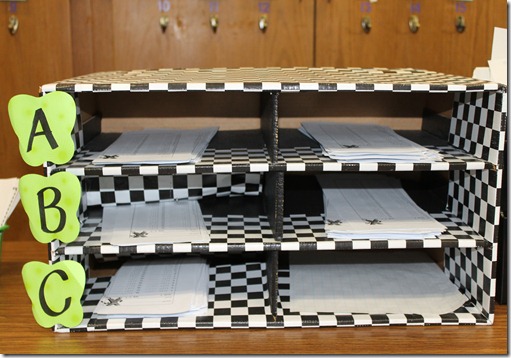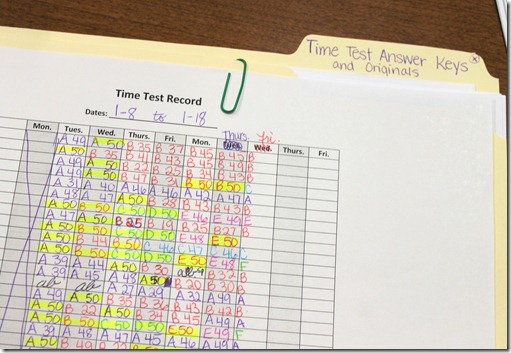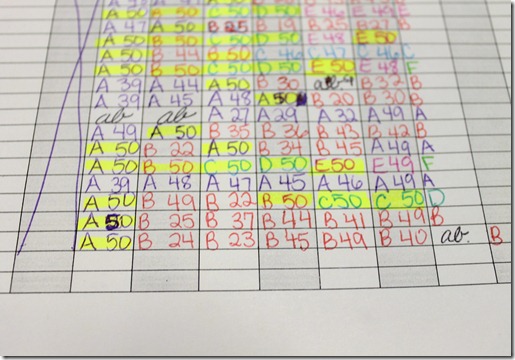As a kid, time tests were always something to groan about. No one really likes them, and as a teacher, I started my career totally against them.
Well, then I realized that teaching kids strategies isn’t always enough. With my current class, we worked and worked and worked on multiplication strategies. I didn’t want them to just use rote memorization.

We made arrays with freebies from Third Grade Gridiron.
We made multiplication flipbooks to show a strategy for each factor. (I apparently didn’t take a picture of these. Oops.)
We read this book (which I got through Scholastic and found to be AMAZING for teaching number-sense-based strategies for multiplication). We have probably read it 10 times, at least, as a class.
We did all of the Envision math lessons (and, for once, I really felt like our math series taught the strategies pretty well!).
We practiced games on the SmartBoard and in the computer lab at Arcademics.com – which the kids love and I found very simple to use. (Plus- free!)
We played all kinds of Bump and Roll-and-Cover games. (A few free ones here from my friend Denise!)
But some of my kids were only able to use the strategies when I reminded them, or their addition skills were so weak that they couldn’t do the multiplication quickly.
I have been using XtraMath to assess my students’ math fact knowledge this year, and I LOVE it. For a free program, I think it’s incredibly well-designed. Now that I’m in a district where almost every family has Internet access, it’s a great way to get parents involved and keep them up-to-date on their student’s progress. Even better- it’s easy for me to set up. After making a teacher account, all you have to do is type in student names, click one button to print all of the personalized parent letters, and set up a classroom code once on your classroom computers.
For each student, it shows me a grid and also a calendar of when they’ve been on and how they’re doing.
While I love this site and the way it moves students through the operations, I found that I really couldn’t assess all of my students’ multiplication facts because some were still on addition and subtraction.
So- sigh- enter the traditional time test. My students get to take one every day FOR SURE (which not all were doing with XtraMath) and there is a sense of urgency for the students that haven’t really kept up with XtraMath on the computers.
Unfortunately, it requires daily grading and tracking for me, and organization of the different levels of time tests. (Yuck.)
Here’s how I do it while staying sane:
First of all, I keep each time test organized in a cardboard paper sorter. I have two of these covered in contact paper that I got from a teacher who was upgrading her ‘mailboxes.’ I’ll stick the other on top of it as my students move through the levels and I need more space. I used Super Sticky Post-Its to label it, and I got the time tests from Super Teacher Worksheets – yes, they are now a subscription site, but SO worth the small cost per year.
When it’s time to take a time test, I tell the students (usually in groups) to go get the paper they need. If they don’t know, I can look it up quickly and easily.
I have all of my originals and answer keys in a file folder. To the front, I paper-clip my records. I have student names along the left side, and then ten spaces for test scores.
When I collect the time tests, I ask students to come up by level (A, B, C, etc.) Yes, the students know how the other students are doing. But we talk a lot about how improvement is the most important, and usually as the kids come up to me, they’re cheering that they got them all done, or I’m complimenting someone on getting closer this time, and it’s not been an issue in my class.
Collecting them by level makes it easy to grade by level. In the box, I record the test level (A, B, C, etc.) and the score out of 50. I color-code each level, which doesn’t actually take that much time.
I pick up the purple pen for the A’s, getting the key out of my folder. I record the A’s before going on. When I switch to B’s, I switch keys and pen color. I place all of the graded-and-passed ones in one pile, and all of the graded-but-didn’t-pass ones in another pile. This makes it easy to add stickers to the Passers before I hand them back.
At the end, I highlight the Passers (those who got 50/50) on my chart.
Look how easy it is at a glance how someone is doing!
Once a week I check to see what levels might need more copies, and I snag the originals out of my folder to do them. Easy peasy!
It still takes time every day. There’s no way around it. But keeping the time tests organized has really helped keep it from eating into my day any more than it has to.
So, do you give you kids time tests to assess their math facts?







Yeah we do. I give it every week on Friday. We do addition and subtraction from 0-10. I also have my kids on XtraMath and send home flash cards, but only a few students are actually moving. So to prompt them along, my grade level is doing an ice cream party where they earn certain things based on what numbers they passed. I'm not entirely sure about that, but it seems to be giving a few kids a kick in the pants to start studying and taking it more seriously. I'll feel bad though when some kids only will get a spoon and no ice cream. :/
ReplyDeleteLiz
Teaching in the Valley